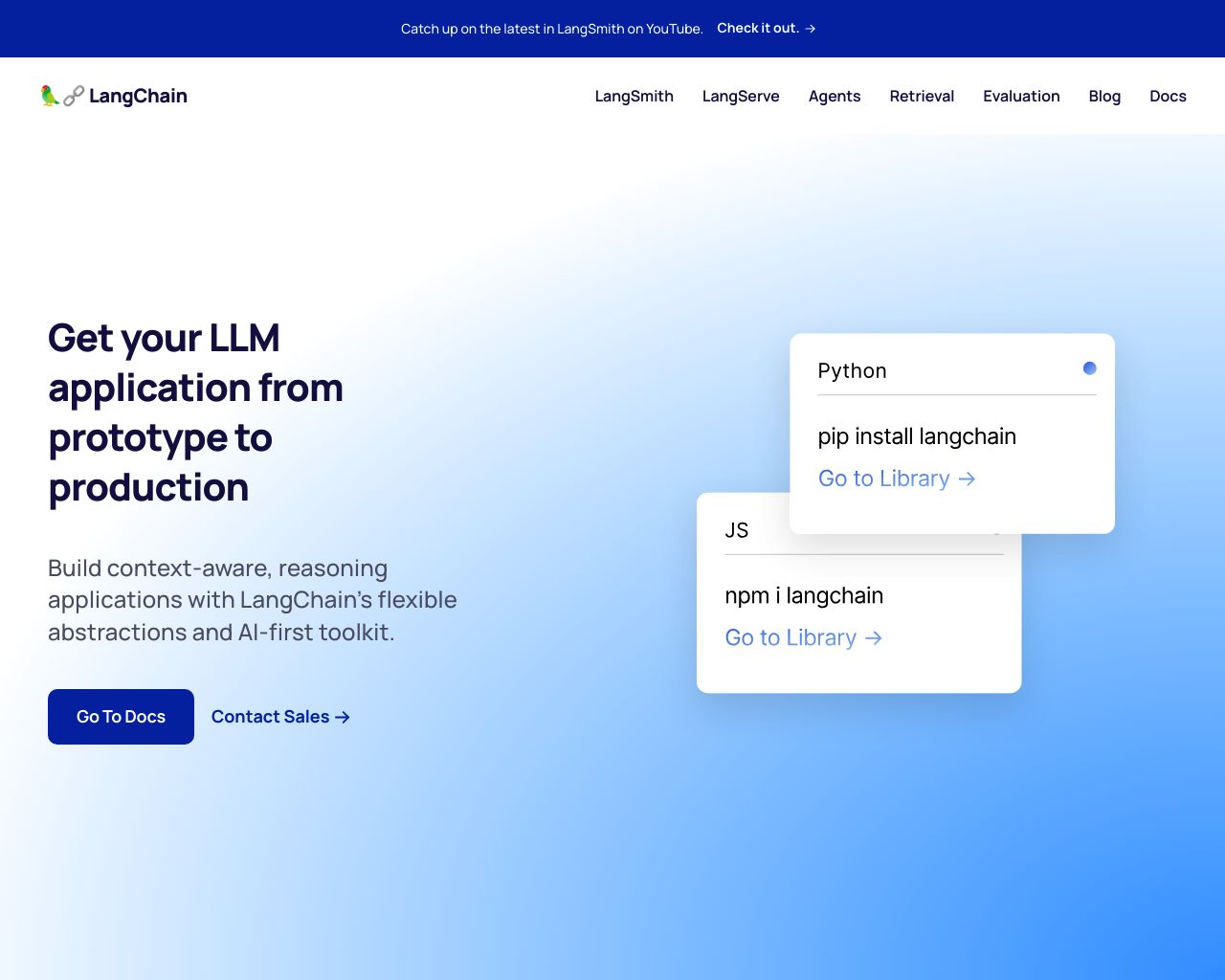LangChain vs. Magic Loops: Comparing AI Development Platforms
AI-powered application development revolutionizes how businesses create intelligent solutions. LangChain vs. Magic Loops, and SmythOS offer unique approaches to harnessing AI capabilities, each catering to different user needs and technical expertise levels.
This comparison explores the strengths and limitations of these platforms, examining their core features, ease of use, and potential applications. Whether you’re a seasoned developer seeking powerful tools for complex AI projects or a business user looking to automate workflows without extensive coding knowledge, understanding these platforms’ capabilities will help you choose the right solution for your AI development needs.
LangChain Overview
LangChain empowers developers to create sophisticated AI applications using large language models. This open-source framework streamlines the entire lifecycle of LLM-powered tools, from development to deployment.
LangChain’s core offering, the LangChain Expression Language (LCEL), provides a declarative way to chain components with optimized execution and seamless tracing. Developers leverage pre-built modules for memory, prompts, and document processing to rapidly prototype and scale AI agents. The platform shines in its flexibility, allowing integration with various LLMs and external data sources.
LangChain empowers developers to create sophisticated AI applications using large language models. This open-source framework streamlines the entire lifecycle of LLM-powered tools…
LangChain excels in building complex, stateful applications through LangGraph. This tool models multi-step workflows as graph structures, enabling the creation of autonomous agents capable of reasoning and decision-making. LangSmith complements development by offering robust debugging, testing, and monitoring capabilities.


While LangChain provides powerful tools for experienced developers, it lacks a visual builder or no-code options. This steeper learning curve may challenge non-technical users seeking to create AI agents. Additionally, the platform’s open-source nature means users must carefully consider security and scalability when deploying production applications.
LangChain’s ecosystem continues to expand, with active development on components like retrieval augmented generation (RAG) and structured output parsing. The platform’s modular design allows seamless integration with popular AI models and third-party tools, positioning it as a versatile choice for developers building next-generation AI applications.
Magic Loops Overview
Magic Loops transforms automation by fusing large language models with code to create programmable workflows. Users describe tasks in natural language, which Magic Loops converts into executable “loops” combining code and AI blocks.


Magic Loops excels in accessibility, allowing users to automate complex tasks without extensive coding knowledge. The platform’s flexibility empowers users to fine-tune loops, ensuring precise automation tailored to specific needs. By leveraging various integrations, APIs, and AI models, Magic Loops creates versatile and powerful automated workflows.
Magic Loops bridges the gap between no-code tools and full programming environments. The platform aims to democratize coding, potentially increasing the proportion of people who can program from 1 in 200 to 1 in 5.
The platform fosters collaboration through its public loops feature, enabling users to share their creations or utilize existing community-built loops. This approach enhances resource sharing and accelerates development. Magic Loops plans to open-source their platform, further expanding customization options and local deployment capabilities.
Magic Loops bridges the gap between no-code tools and full programming environments. The platform aims to democratize coding, potentially increasing the proportion of people who can program from 1 in 200 to 1 in 5. By leveraging state-of-the-art generative AI, Magic Loops empowers users to harness programming capabilities without extensive coding expertise.
While Magic Loops offers impressive automation capabilities, it lacks some features found in more comprehensive AI agent builders. The platform doesn’t provide a visual builder or no-code editor, which may limit accessibility for non-technical users. Additionally, Magic Loops doesn’t offer specific features like constrained alignment, hosted vector databases, or deployment options as webhooks or scheduled agents.
Feature Comparison
LangChain and Magic Loops offer distinct approaches to building AI-powered applications, each with its own strengths and limitations. LangChain provides a robust framework for developers to create sophisticated LLM applications, while Magic Loops aims to simplify automation through natural language descriptions.
LangChain excels in providing developers with powerful tools for building complex AI applications. Its LangChain Expression Language (LCEL) enables declarative chaining of components, optimized execution, and seamless tracing. LangChain also offers advanced features like LangGraph for modeling multi-step workflows and LangSmith for debugging and monitoring. However, LangChain lacks a visual builder or no-code editor, which may present a steeper learning curve for non-technical users.
Magic Loops, on the other hand, focuses on accessibility and ease of use. It allows users to describe tasks in natural language and converts them into executable ’loops’ combining code and AI blocks. This approach makes automation more accessible to users without extensive coding knowledge. Magic Loops also offers public loops for sharing and collaboration. However, it lacks some of the more advanced features found in LangChain, such as sophisticated debugging tools or extensive API integrations.
In contrast, we offer a comprehensive solution that combines the best of both worlds. Our platform features a user-friendly visual builder and no-code options, making it accessible to users of all technical levels. We also provide advanced capabilities like hosted agents, multi-agent collaboration, and extensive API integrations. Our platform excels in areas where both LangChain and Magic Loops have limitations, offering a more complete and versatile solution for AI agent development and deployment.
Feature Comparison Table
| LangChain | Magic Loops | SmythOS | |
|---|---|---|---|
| CORE FEATURES | |||
| Hosted Agents (Dev, Production) | ✅ | ❌ | ✅ |
| Environments (Dev, Production) | ✅ | ❌ | ✅ |
| Visual Builder | ❌ | ❌ | ✅ |
| No-Code Options | ❌ | ✅ | ✅ |
| Autonomous Agents | ✅ | ❌ | ✅ |
| Multimodal | ✅ | ❌ | ✅ |
| Multi-Agent Collaboration | ✅ | ❌ | ✅ |
| Audit Logs for Analytics | ✅ | ❌ | ✅ |
| Work as Team | ✅ | ❌ | ✅ |
| Agent Work Scheduler | ❌ | ✅ | ✅ |
| SECURITY | |||
| Constrained Alignment | ❌ | ❌ | ✅ |
| Data Encryption | ✅ | ❌ | ✅ |
| OAuth | ✅ | ❌ | ✅ |
| IP Control | ❌ | ❌ | ✅ |
| COMPONENTS | |||
| Foundation AIs | ✅ | ❌ | ✅ |
| Huggingface AIs | ✅ | ❌ | ✅ |
| Zapier APIs | ❌ | ❌ | ✅ |
| Classifiers | ✅ | ❌ | ✅ |
| Data Lakes | ❌ | ❌ | ✅ |
| DEPLOYMENT OPTIONS (EMBODIMENTS) | |||
| Deploy as Webhook | ❌ | ✅ | ✅ |
| Staging Domains | ❌ | ❌ | ✅ |
| Production Domains | ❌ | ❌ | ✅ |
| Deploy as Site Chat | ✅ | ❌ | ✅ |
| Deploy as Scheduled Agent | ❌ | ✅ | ✅ |
| Deploy as GPT | ✅ | ❌ | ✅ |
| DATA LAKE SUPPORT | |||
| Hosted Vector Database | ❌ | ✅ | ✅ |
| Sitemap Crawler | ❌ | ❌ | ✅ |
| YouTube Transcript Crawler | ❌ | ❌ | ✅ |
| URL Crawler | ❌ | ❌ | ✅ |
| PDF Support | ✅ | ❌ | ✅ |
| Word File Support | ❌ | ❌ | ✅ |
| TXT File Support | ✅ | ❌ | ✅ |
Best Alternative to LangChain and Magic Loops
SmythOS stands out as the superior alternative to LangChain and Magic Loops for AI agent development and deployment. Our platform combines powerful features with user-friendly design, making advanced AI capabilities accessible to users of all skill levels.
Unlike LangChain’s developer-focused approach or Magic Loops’ simplified automation, we offer a comprehensive solution that caters to both technical and non-technical users. Our intuitive drag-and-drop interface and no-code options democratize AI development, allowing anyone to create sophisticated agents without extensive programming knowledge.
Our intuitive drag-and-drop interface and no-code options democratize AI development, allowing anyone to create sophisticated agents without extensive programming knowledge.
We excel in areas where LangChain and Magic Loops fall short. Our platform supports hosted agents in both development and production environments, ensuring seamless deployment and scalability. Multi-agent collaboration, a feature absent in Magic Loops, enables complex task handling and workflow optimization. We also provide robust security features, including data encryption and OAuth support, addressing enterprise-level concerns that Magic Loops lacks.
Our extensive integration ecosystem surpasses both competitors. We support a wide range of AI models, APIs, and tools, including Zapier integrations, which neither LangChain nor Magic Loops offer. This versatility allows users to create AI solutions that seamlessly fit into existing business processes and workflows.
With SmythOS, users gain access to advanced deployment options, including webhooks, site chat, and GPT integration. Our platform’s scalability and hosted vector database support enable efficient handling of large-scale AI operations, features not available in LangChain or Magic Loops. By choosing SmythOS, users unlock the full potential of AI agent technology, driving innovation and efficiency across their organizations.
Conclusion
LangChain, Magic Loops, and SmythOS each offer unique approaches to AI-powered application development, but SmythOS stands out as the superior choice for businesses and developers seeking a comprehensive, user-friendly solution.
LangChain provides a robust framework for experienced developers, offering powerful tools like LangGraph and LangSmith. However, its steep learning curve and lack of visual building tools may deter non-technical users. Magic Loops simplifies automation through natural language descriptions, making it accessible to a wider audience. Yet, it falls short in advanced features and deployment options.
SmythOS combines the best of both worlds, offering a visual builder and no-code options alongside advanced capabilities. Our platform excels in areas where both LangChain and Magic Loops have limitations. We provide hosted agents, multi-agent collaboration, and extensive API integrations, making it a versatile solution for users of all technical levels.
For those ready to experience the future of AI agent development, we invite you to explore our diverse range of AI-powered agent templates. These templates cover multiple business categories and are designed to streamline processes across various functions. To see how SmythOS can transform your workflow, create a free SmythOS account and start building AI agents with no time limit or risk. With our platform, you’ll be able to deploy SmythOS agents anywhere, from chatbots to APIs, revolutionizing your business operations and customer engagement strategies.
Last updated:
Disclaimer: The information presented in this article is for general informational purposes only and is provided as is. While we strive to keep the content up-to-date and accurate, we make no representations or warranties of any kind, express or implied, about the completeness, accuracy, reliability, suitability, or availability of the information contained in this article.
Any reliance you place on such information is strictly at your own risk. We reserve the right to make additions, deletions, or modifications to the contents of this article at any time without prior notice.
In no event will we be liable for any loss or damage including without limitation, indirect or consequential loss or damage, or any loss or damage whatsoever arising from loss of data, profits, or any other loss not specified herein arising out of, or in connection with, the use of this article.
Despite our best efforts, this article may contain oversights, errors, or omissions. If you notice any inaccuracies or have concerns about the content, please report them through our content feedback form. Your input helps us maintain the quality and reliability of our information.
